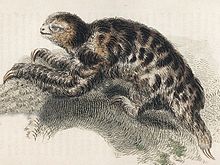
Back كسلان قزم Arabic كسلان قزم ARZ Mindegol (Bradypus pygmaeus) AVK Cırtdan ərincək Azerbaijani Трипръст ленивец джудже Bulgarian Lezireg korr Breton Peresós pigmeu Catalan Bradypus pygmaeus CEB Lenochod trpasličí Czech Zwergfaultier German
| Pygmy three-toed sloth | |
|---|---|

| |
| Scientific classification | |
| Domain: | Eukaryota |
| Kingdom: | Animalia |
| Phylum: | Chordata |
| Class: | Mammalia |
| Order: | Pilosa |
| Family: | Bradypodidae |
| Genus: | Bradypus |
| Species: | B. pygmaeus
|
| Binomial name | |
| Bradypus pygmaeus | |

| |
| Range of the pygmy three-toed sloth | |
The pygmy three-toed sloth (Bradypus pygmaeus), also known as the monk sloth or dwarf sloth, is a species of sloth in the family Bradypodidae. The species is endemic to Isla Escudo de Veraguas, a small island off the Caribbean coast of Panama. The species was first described by Robert P. Anderson of the University of Kansas and Charles O. Handley Jr., of the Smithsonian Institution in 2001. The pygmy three-toed sloth is significantly smaller than the other three members of its genus, but otherwise resembles the brown-throated three-toed sloth. According to Anderson and Handley Jr., the head-and-body length is between 48 and 53 centimetres (19 and 21 in), and the body mass ranges from 2.5 to 3.5 kg (5.5 to 7.7 lb).
This sloth, like other extant sloths, is arboreal (tree-living) and feeds on leaves. It has a body adapted to hang by its limbs; the large curved claws help the sloth to keep a strong grip on tree branches. It lives high in the canopy but descends once a week to defecate on the forest floor.[3] It is symbiotically associated with green algae, that can provide it with a camouflage. Details of mating behavior and reproduction have not been documented. The pygmy three-toed sloth is found exclusively in the red mangroves of Isla Escudo de Veraguas, restricted to an area of 4.3 square kilometres (1.7 sq mi). A 2012 census of pygmy three-toed sloths estimated the total population at 79. The IUCN lists the pygmy three-toed sloth as critically endangered and they are listed on the world's 100 most threatened species.
- ^ Voirin, B.; Smith, D.; Chiarello, A.; Moraes-Barros, N. (2014). "Bradypus pygmaeus". IUCN Red List of Threatened Species. 2014: e.T61925A47444229. doi:10.2305/IUCN.UK.2014-1.RLTS.T61925A47444229.en. Retrieved 19 November 2021.
- ^ "Appendices | CITES". cites.org. Retrieved 2022-01-14.
- ^ "Amazing Facts about the Three Toed Sloth | OneKindPlanet Education". OneKindPlanet. Retrieved 2019-06-12.
